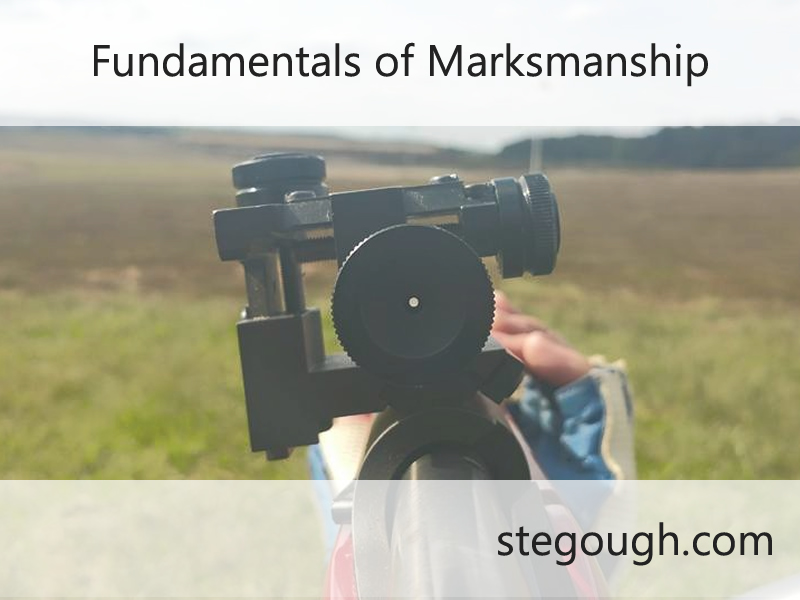Shooting Accurately; The Fundamentals of Marksmanship
Whether you are shooting pistols or rifles, air or full-bore, there are 4 fundamental principles which must be applied in order to shoot accurately.
The best marksmen the world over employ these 4 points when they take every single shot. With practice and time, they become automatic, but when you’re starting out these are the 4 most important principles that you must concentrate on to tighten your groups, and effectively shoot more consistently, and ultimately more accurately.
Each aspect of these 4 fundamentals can be taught differently, and over the years the wisdom of how to do something best has always been changing, the ultimate advice I can give is to do what is comfortable and natural to you. We are all different sizes, shapes and abilities. Only we can ultimately decide what works best for us.
Whilst it is not a fundamental in itself, the most important aspect of shooting, and what using these fundamentals will re-enforce is that of; Consistency.
The Key To Precision Shooting: Consistency
- Consistency is key to shooting accurately and repeatedly.
- Consistency in your approach to taking a shot.
- Consistency in your equipment.
- Consistency in your ammunition.
- Consistency in yourself.
- Learn and apply the following 4 fundamentals of Marksmanship, consistently, and you will become a better shot for it.
Marksmanship Fundamental: Steady Position
- Prone, Sitting, Kneeling, Rested, Supine, or Standing. You must be steady in your position and confident in it. Any amount of unease and teetering of your position will be enough to see your group open up as you are not in a consistent state.
- When shooting rifles you must ensure that the trigger hand has a firm hold on the pistol grip with a slight steady rearward force on the rifle holding it into the shoulder. The supporting hand should be under the rifle at the fore-end and the rifle should be rested on this hand with as little grip as possible – ideally resting on the hand.
Marksmanship Fundamental: Natural Point Of Aim
- An often overlooked, but hugely important factor of shooting accurately is using your Natural Point Of Aim to align your shots. This is your natural, optimum position to be in to take any shot.
- You must never ‘muscle’ the rifle into the aim – make small (or sometimes big) adjustments to your whole position to ensure that your natural alignment is pointing your firearm at the target.
- A good way of testing where your natural point of aim is, is to take the firearm, get in to position on the firing point and with your eyes closed, get into position and aim the firearm towards the target. (Still with your eyes closed). Open your eyes, and look at where you are pointing. If you are not pointing at the target, you will need to move your body so it is in the same comfortable, natural position, but the firearm is pointing at the target, rather than pushing the rifle without moving your body.
Marksmanship Fundamental: Sight Alignment/Sight Picture
- Whether you are using iron sights or optics, sight alignment is paramount.
- Parallax is the enemy, consistency in placement of the eye behind the scopes is imperative to an accurate, repeatable shot. It is quite easy to demonstrate the effect of parallax, especially with an optical sight, however the issue is the same on iron sights. Take a telescopic sight and attach it to something that won’t move, take a chair for example. Line the scope up with an item in the distance, then let people move behind the scope, without moving the chair and see how much variation there is when eye placement is not consistent. ~ Some scopes are affected less than others, but most if not all will show this effect.
- This brings us nicely on to Cheek Weld, Whilst some consider this a fundamental in it’s own right, it is not an all encompassing fundamental throughout all disciplines, for example, pistols do not require a cheek weld (don’t try, getting hit in the mouth with a pistol slide will hurt!). But what a consistent Cheek weld, where appropriate, does bring to the table, is a consistent sight alignment.
- Where you are shooting at the same distance regularly, which is good practice whilst trying to learn to shoot in the early days, it is worth taping something small, like a piece of rice to the cheek piece of the stock you are using, so you can feel when your cheek returns to the same place on the stock each time you sight up.
- When shooting groups and wanting the ultimate accuracy, the best case is to not remove your cheek weld at all throughout the string of shots, so there is no chance at all of variation of eye placement.
- Sight Picture should be given due consideration. Of course a well-sighted rifle should be aligned so that with Good Sight Alignment and Good Cheek Weld, the sight picture is squarely at the center of where the firearm will shoot. When the shooter takes the shot, the focus of the shooters eye should be on the foresight and the foresight should be in clear focus, the rest of the sight picture will become blurry (rearsights and target). In Optics, the same applies, however instead of the foresight in clear focus, the cross hairs should be in clear focus, it is possible that both the cross hairs and target will be in clear focus during this time, but the concentration should be on exactly where that cross hair is pointing.
Marksmanship Fundamental: Shot Release and Follow Through
- Shot Release and Follow Through essentially is the milliseconds before, order roche valium online during and after the shot. As such, although I have considered it one fundamental, there are multiple parts and things to think about all at the same time. So let’s break this down.
- Breathing Control.
- Breathing can be easily linked to your natural point of aim. When you breathe in, your sights and point of aim drop, when you breathe out, your sights and point of aim rise.
- There are a number of techniques that work for different people, and again in different disciplines, different techniques work better than others, however making sure that you are consistent with the breathing technique you use is paramount.
- Whether you breathe in, hold, shoot. Or breathe out, hold, shoot. You should be consistent.
- You should aim not to hold your breathe for longer than 2-3 seconds, any longer and the body starts to get deprived of oxygenated blood and it leads to an unsteady hold as your muscles start sending your brain panic signals that they need more oxygenated blood. Simply breathe again and attempt the shot. – This cannot be overstated, as a competition shooter, simply pulling the trigger because I’ve been in hold for too long is a lot to blame for my bad shots. You must be disciplined, unlike me. If you’re not following the fundamentals, reset yourself, and make sure you are before you continue.
- Breathe in, or Breathe out and hold. It is impossible to measure half a breath with any consistency, if you want to shoot with precision, don’t bother trying.
- Trigger Control.
- ‘The skillful manipulation of the trigger without disturbing the alignment relative to the target’. – UK NRA Probation Manual.
- It sounds so simple, doesn’t it. Pull the trigger when everything is lined up. Only, it’s not quite that straightforward. There are a number of factors to take into account on something so simple as a trigger action.
- Pull the trigger straight back. You must impart not lateral pressure on the trigger or firearm, so that the position is not disturbed.
- For me, I was always taught to use the pad of my finger, since there are more nerves in this part of the finger, as opposed to the joint. Essentially you should use what is most comfortable to you, and what you find most repeatable. Don’t alternate or change between pad and joint and expect any kind of consistency.
- You should not anticipate the firearm going off, trigger pull should be steady and straight and the rifle should go off whilst you are not expecting it, concentrating on your hold, sight picture and aiming mark. Failure to do this often results in a flinch where you are expecting the firearm to go-off, which almost always results in disturbing the sight picture. The best way to overcome this is with dry-firing. Practice shooting your firearm without live rounds so that your body is conditioned to pulling the trigger without the recoil, so you do not anticipate the recoil.
- Follow Through.
- Most people assume that as soon as the trigger is pulled, that the shot has gone – whilst the time-line that we are talking about might indicate that to be true when we compare to things from our day-to-day life. When shooting it is not quite accurate, so we need to squash that right now.
- Follow through is the procedure of staying in hold, and staying ‘on-target’ after the trigger has been squeezed, after the firearm has recoiled, and after the rifle/pistol returns to it’s natural point of aim. You’ve not released the trigger, breath or hold.
- This ensures that during the milliseconds after pulling the trigger, the trigger sear releasing, the hammer swinging, hitting the firing pin which hits the primer/rim which ignites the powder and sends the projectile hurtling down the barrel, that nothing external to the moving parts of the firearm, moves.
- This is important for all shooters, but a good habit to get new shooters into from the get-go. There is an overwhelming desire for new shooters to pull the trigger, and before the shot has gone, the head moves off the cheek piece to look down the scope to see where it went, whilst the bullet has long gone by the time this happens, there is an anticipation to look which can often come before the shot has even been released.
- Experienced shots, can often tell where a round has gone, simply from the follow through, as the follow through highlights any ‘muscling’ as the firearm returns to rest in the natural point of aim.
Fundamentals Of Marksmanship
Whilst this document is already at some 1700 words, I do feel that I have barely scratched the surface. Whilst I have touched on each of the Fundamentals of Marksmanship, I do not feel like this is a be-all and end-all guide for shooting with Precision. It should, however, if used as a guide to help you know what to focus on when starting out, be a guide to helping you shoot with some consistency, and accuracy and precision are born out of consistency.














11th October 2017 at 12:00 pm
You forgot the 5th marksmanship principle.
“The shooter must have a positive mental attitude” I hear this is now being taught at Warminster and Lanny Bassham’s mental management input has been in the DCCT coaching manual for some years. 80% + is mental.
Also the follow through is essential to spot fall of shot. Not so much with singly marked back rounds but more so for the more demanding disciplines.
11th October 2017 at 12:24 pm
Thanks for the input, Chris.
I had touched briefly on experienced shots using follow through for telling where that round went, I didn’t talk about positive mental attitude. It is essential to be successful in shooting sports competitively, and it does not only apply to shooting, but all competitive sports. Good spot!
12th October 2017 at 8:29 pm
Great piece, hope you’ll write a few more